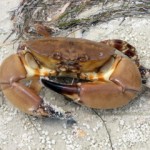
A stone crab is a heavy shelled crustacean whose black tipped claws are highly regarded for their sweet delicate meat. There are actually two species of stone crabs; one named Florida stone crab which occurs south of Tampa Bay around to the Atlantic and a close cousin which is darker brown to maroon in color which occurs west of Cape San Blas all the way to Mexico.
SEASON
Stone Crab harvest season opens October 15th running to May 15, 2016 for Florida’s Atlantic waters and throughout the Gulf of Mexico. The protected spawning season runs from spring through summer each year.
Claws must have a length greater than 2-3/4 inches at the propodus, the larger immovable part of the claw.
WHERE DO THEY COME FROM
Stone Crabs are native to the Gulf of Mexico, up the Atlantic Coast as far north as Cape Hatteras, North Carolina and south through the island towards Cuba. Florida’s Gulf waters produce 75% of the commercial harvest.
DOES HARVESTING THE CLAWS KILL THE CRAB
When the claws are harvested by the proper technique that allows a diaphragm to seal the brake so that the crab will not bleed to death. One or both claws may be taken from mature crabs of about 3-1/2 years of age of both sexes excluding Ovigerous females. The live crabs are returned to the ocean where they are trapped so they may protect themselves by hiding in their burrows. Their claws will grow back during the natural molting processes over about 1 year period. They may be harvested again but are usually smaller in size, often referred to as “retreads”.
WHAT ABOUT FEMALE CRABS
Ovigerous females carrying eggs and egg sacs are prohibited from harvesting claws and must be returned to the water immediately and unharmed. Stress from being trapped and removed from the water can cause loss of eggs. It is illegal to harvest claws from Ovigerous females.
HOW IS THE CRAB CLAWS HANDLED
The stone crab claws are cooked on the boat or when returned that day to shore to preserve the quality of the meat. The stone crab claw meat will stick to the shell when lowered below 36 degrees F. making icing and freezing the claws for storage impractical. Stone crab claws are best eaten freshly caught and cooked.
WHY DO THEY TASTE SO GOOD
The very heavy shell of the claw protects the meat of the crab from penetration of diluting steam and moisture during cooking to preserve that special delicate flavor. The stone crab has a unique resilient texture yet silky to the bite.
WHY ARE THEY GOOD TO EAT
Crab meat is high in protein and low in fat and calories, before the traditional dipping sauces.
HOW MANY MAKE A POUND
It takes about 2-1/2 pounds of stone crab claws to yield 1 pound of cleaned meat.
Claws are graded as
• medium which are under 3 ounces each 6 to 8 per pound
• large which are 3 to 5 ounces each 4 to 6 per pound
• jumbo more than 5 ounces each 1 to 3 per pound
PREPARING YOUR STONE CRABS
The stone crab claw must be first separated from the arm by grabbing the claw in one hand with the stationary finger upward and pressing downwards with the end of the arm onto a cutting board. This motion is against the natural range of motion and will separate the arm from the claw at the joint. The arm may be cracked open with the back of a heavy knife or cooking mallet. Collect the meat.
For the claw bend the moving finger sideways to crack and loosen, then carefully remove without tearing the rest of the claw meat. Crack the palm of the claw with your mallet at the sides to remove the shell and free up the claw meat. Since the meat has been cooked it is ready to serve and enjoy.
COOKING
Cooking of the stone crab usually means reheating the meat. Simply place the entire claw and arm into a steamer and cook for about 5 minutes so that the heat may penetrate the hard shell. Crack and serve after heating to best preserve the delicate sweet flavor.
REFERENCES
How to Harvest a Stone Crab Claw
https://www.youtube.com/watch?feature=player_embedded&v=YTgXTS8gLjU
Florida Fish and Wildlife Conservation Commission
http://myfwc.com/fishing/saltwater/commercial/stone-crab/
http://myfwc.com/news/news-releases/2014/october/08/stone-crabs/
http://m.myfwc.com/research/saltwater/crustaceans/stone-crabs/faq/
http://www.stonecrabflorida.com/stone-crab-facts.html



